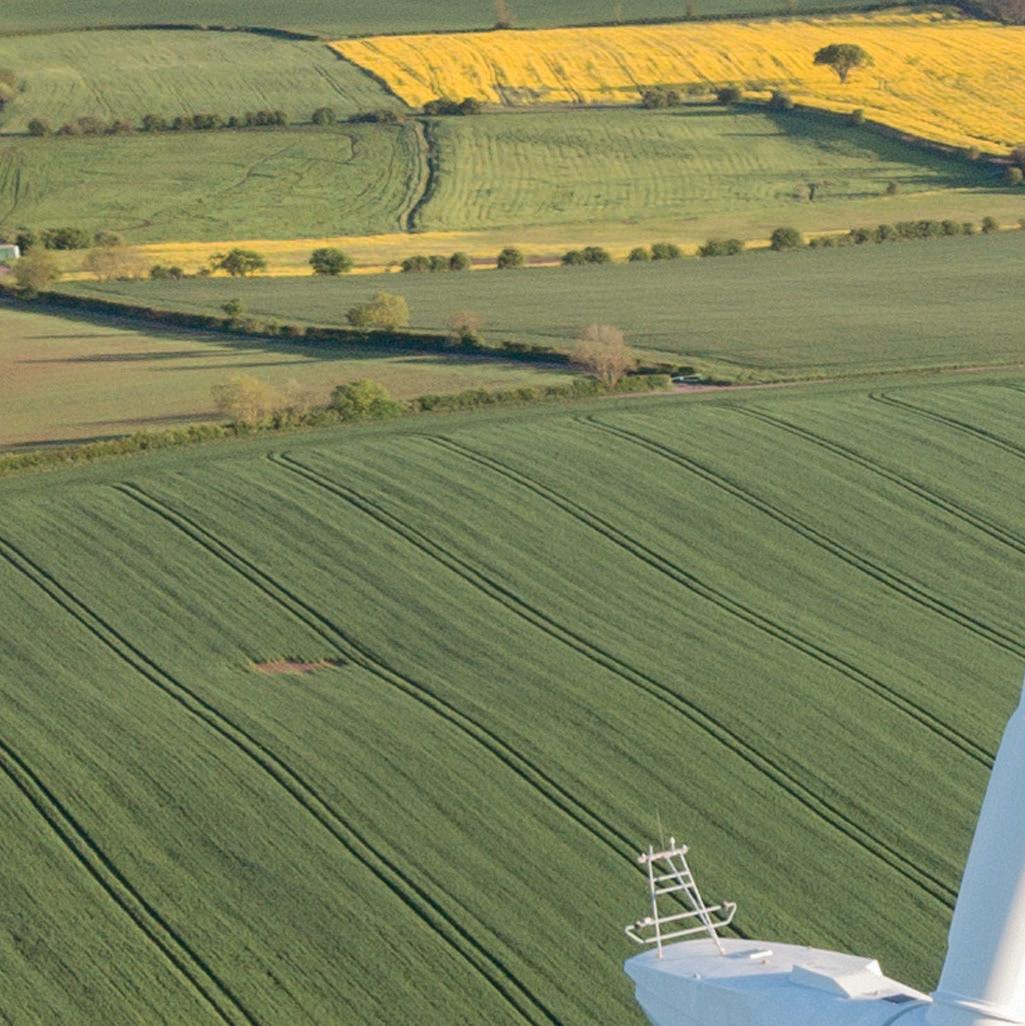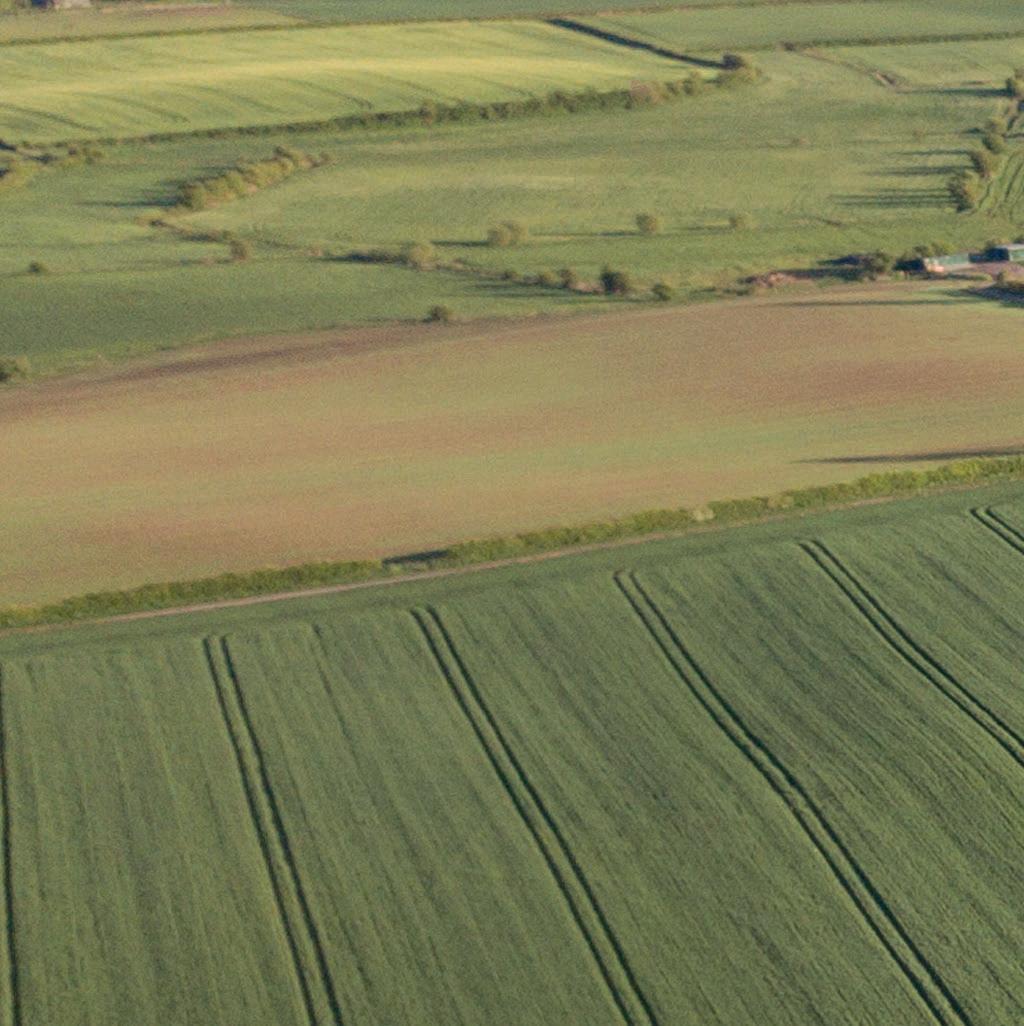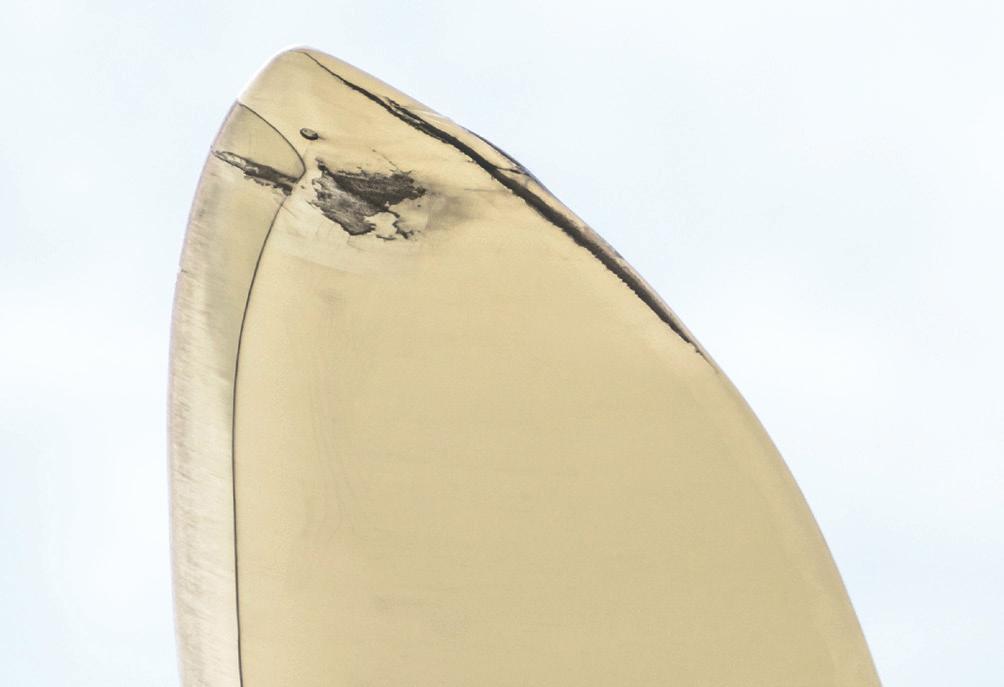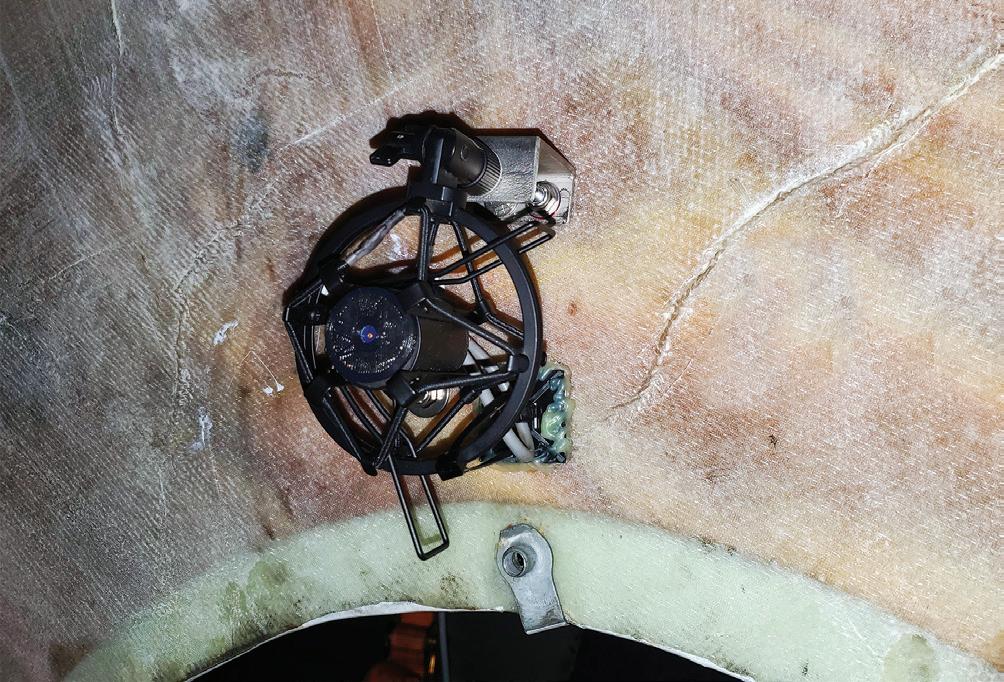
12 minute read
The future of wind blade integrity



Valery Godinez and Keith Respet, Sensoria™ by
MISTRAS, USA, provide an overview of a blade monitor that utilises advanced acoustic emission technology to remotely detect damages and visualise blade integrity.




As wind turbine blades operate on a daily basis, the threat of unseen and unexpected damage that can seriously impact blade reliability and productivity constantly looms. Particularly with the industry standard of conducting infrequent blade inspections, damage can occur and worsen in between scheduled inspections, leading to unplanned downtime and higher maintenance expenses. Wind farm operators and fleet engineers need blade management solutions that make their operations smarter. Acoustic emission (AE) monitoring technology – such as the tech utilised by Sensoria™, a new 24/7/365 blade monitor developed by MISTRAS Group – provides a resolution; operators and engineers can gain continuous data on their blade’s integrity, while actually extending the intervals between scheduled inspections.
The Q&A here helps to explain how remote, AE monitoring technology is changing the face of blade integrity management in the digital age.


Q. To keep equipment operating safely and efficiently, routine inspection is vital. How does acoustic emission testing work, and how is it different than other non-destructive testing methods?


AE testing monitors the behaviour of materials performing under stress by ‘listening’ to the sounds of growing cracks, breaking fibres, and other forms of active damage. When damage forms in a material, it makes noise, even if it is too quiet to be heard by the human ear. Small scale damage elicits minor frequencies and releases of energy that are picked up by AE sensors, such as the Sensoria sensors that are installed in turbine blades. AE testing is based on different foundational principles than other non-destructive testing (NDT) methods, such as ultrasonic testing (UT), radiography (RT), or eddy current (EC). In those cases, the detection mechanism is based on interaction with the defect geometry; they introduce some type of energy into the material and look at the interaction between the energy and the defect, with results in the form of signals or images that showcase the presence of existing defects.
In the case of AE, the detection mechanism is based on the defect generating its own signal. Defects in structures (such as turbine blades) act as stress intensifiers; even when the overall load on the structure is below dangerous levels, local stresses at the edges of the defects may raise to dangerous values. Under these conditions, and depending on their type, size, location, loading, and other factors, defects become ‘active’ and produce AE that is picked up by the AE sensors. Another important difference between AE and other NDT methods is that AE sensors can be remote from the damage. While other NDT methods require a sensor to be placed directly on top of a damage to detect it, AE sensors are strategically placed to detect sound waves that travel throughout the materials.

Q. How can the data provided by AE blade monitoring technology generate value for users?
Timely and accurate blade integrity data is paramount to maximising performance and effectively and efficiently making decisions on blade health.
AE technology in particular has important benefits for the future of wind blade integrity. Tracking transient and dynamic changes in acoustic signatures of wind turbine blades over time is necessary to detect damage and track damage progression. Tracking of acoustic signatures and background noise can be used by asset owners to prioritise inspection and manage asset operations.
The data collected continuously by the solution can be used to determine the acoustic response of each blade during operation, identify whether the blade acoustic noise changes over time, and compare them to the acoustic noise produced by the other blades in the turbine.
Q. Why is remote, continuous AE monitoring of wind turbine blades more effective than individual, manual inspections?
AE technology is a unique form of NDT that generates several useful benefits for wind turbine operations when used for continuous monitoring.
Blades are typically inspected infrequently, with some blades being inspected every few months, while others can go well over a year without undergoing inspection and testing. Since wind turbine blades are such massive at-height structures, it is all but impossible to see the formation of initial active damage from ground level, and even if drones are used for close proximity visual inspection, damage not open to the surface would not be detected. This allows defects to worsen over time and become more severe by the time they are discovered. This can potentially lead to secondary damages, increased maintenance costs, and longer downtime.
Damages not open to the surface or located inside the blades can be detected in real-time by AE sensors installed on turbine blades. Rather than scheduling routine inspections, with AE monitoring

technology such as the technology used by Sensoria, wind turbine blade integrity is constantly being monitored, enabling operators to proactively stay aware of true blade integrity.
Beyond wind turbine blades, AE technology can also be used to help operators keep tabs on the integrity for other assets throughout a wind farm. Other wind farm assets that AE successfully monitors include: > Wind turbine hubs. > Offshore monopiles. > Wind farm substation transformers.
This rapid form of detecting potential damage allows issues to be assessed and if necessary, mitigated more quickly. This allows for the overall reduction of turbine failure and keeps wind operations continuing as expected for successful energy generation.
Q. What are the common defects that are found when inspecting wind turbine blades?
When inspecting wind turbines, common defects that are found on blades include: > Lightning strikes. > Blade skin ruptures and perforations (including those caused by leading-edge erosion). > High energy impacts. > Cracking and delaminations.
High energy impacts can occur from weather, wildlife, and other unexpected causes. These impacts can result in sudden and detrimental damage to blades that is not always visible. Lightning strikes are another common type of damage that wind turbines undergo. Turbines are susceptible to lightning strikes due to their height and material. In the most extreme cases, lightning damage can fully damage the entirety of a turbine structure, but in more minor cases, lightning will cause less visible, yet still impactful damage, as the impact can lead to secondary damage if not properly detected and mitigated.
Blade skin ruptures and perforations can occur from a multitude of sources, but like many forms of blade damage, they reduce production and can lead to failure if severe enough. The smoothness and flow of sleek turbine blades is a major aspect of how they properly operate and generate energy. When these pristine skin surfaces are ruptured in any way, operations will be negatively impacted.
Cracking and delaminations are some of the most common damages that blades are subjected to. They can occur because of harsh environmental conditions, which introduce abnormal mechanical loads to the blades, or by small manufacturing defects, such as wrinkles over time. When cracking forms on a blade, its structural integrity is negatively affected. Cracks can lead to catastrophic structural failure, and also affect other parts of the turbine.

Figure 1. Defects on blades are sometimes visible but often hidden. MISTRAS uses advanced acoustic emission (AE) technology to proactively detect damages including lightning strikes, skin perforations and ruptures, cracking, and more.
Q. How is AE data transferred after damages are detected through the monitor?
AE sensors are installed on wind turbines – with one sensor installed within each of the three blade bulkheads, and a data acquisition system installed in the turbine hub. The sensors and data acquisition system continuously feed real-time acoustic data to the Sensoria Insights data-driven web application portal via cellular network or Wi-Fi, which makes all current and historical blade integrity data available to site managers, fleet engineers, and operations teams.
The Sensoria Insights portal is an important, innovative tool that meets the needs of the digital age. It allows monitoring data to be viewed by operators in real-time, including on mobile devices. In a world where remote work is more common, this feature allows operators to still be ‘in the know’ of turbines while at home or on other sites.
Q. Once defects have been acknowledged, what methods are carried out to reinstate the quality of the turbine blades?
Analysis, review, and repair are carried out to reinstate turbine blade quality once defects have been detected.
When an instance of damage initially occurs to a wind turbine blade, the programme’s AE sensors will ‘listen’ to this change in structure and send this notification to a key performance indicator (KPI) portal. After damage is detected, users receive real-time mobile alerts to enable immediate action. All blade integrity data – from a single blade to an entire turbine fleet – is stored in the Sensoria Insights data portal, making blade data accessible and actionable from anywhere in the world. The accuracy of the sensors allows the precision down to which blade is damaged to be known. Operators can review this data, assess the severity of the situation, and determine whether immediate action should be taken or if repairs can wait until the next scheduled outage.
If immediate action is required, rope access technicians or drone operators investigate the defect to more closely evaluate the severity, and perform the necessary maintenance and repair activities, such as coating, painting, blasting, or other sorts of component replacement and repairs. These activities can be conducted by the site’s on-site operations teams, or via optional Sensoria dispatch services, through which highly-trained and certified professionals can be requested for additional support.
Q. Inspecting blades whilst they are in operation to check for defects and make repairs can help maintain their safety and uptime, but what services can be implemented back in the manufacturing stage to limit such future defects?
The manufacturing of blades plays a major role in how much blades can withstand while in commercial use, and how long they will last. Manufacturing flaws in blade components can include surface cracking, incomplete penetration, lack of fusion, porosity, and more. All blade materials and componentry must undergo proper laboratory quality assurance and quality control (QA/QC) testing prior to being placed into service, and proper testing can be the difference between blade failure or long-lasting production.
Once wind turbine blades are properly manufactured and tested, the transportation process can be important to their health and sustainability. Blade transportation is another area of wind blade integrity management in which an AE monitoring solution such as Sensoria can help operators to find value. Transportation of such large componentry is difficult and expensive and requires co-ordination from many people throughout a wind energy organisation. These stresses are increased when considering the burden that procuring, shipping, and storing spare blades can cause, as site operators often are not aware of the actual conditions of their blades and thus need multiple back-ups available. With the real-time integrity data that monitoring provides, operators, engineers, and procurement and logistics personnel can realise value throughout the wind blade value chain by reducing the need for unnecessary spare parts.
Q. Does the company constantly improve its technology as information from the data is actioned?
MISTRAS Group research and development (R&D) teams have a long and proven legacy of working with customers in advancing acoustic emission solutions to solve asset protection problems.
For decades, MISTRAS has been a leader in the development and engineering of advanced AE technology. This legacy of R&D using AE is the foundation for the innovative use of Sensoria to enhance wind turbine blade management. Sensoria was created out of a need from wind energy customers for accurate, timely blade integrity data to make their operations smarter. Wind turbine operators now have a trusted and evidence-backed solution to keep turbine blades running effectively.
Q. Why does an integrated approach to blade management work more succinctly for a wind farm operator than using multiple vendors for inspection/repairs/etc.?
In today’s digital, fast-paced business world, reducing the number of providers and players for any task, while also generating more intelligent insights throughout the process, is key to generating value.
When a separate vendor is utilised for each part of blade management, from inspection, to repairs, to having a software provider for data reporting, lines can get crossed, timelines can become extended, paperwork increases, and communication lapses increase, as one wind farm team can only do so much. Having one provider for all aspects of wind turbine blade management ensures that integrity data from a single blade all the way up to an entire global fleet can be housed in a single database, enabling site operators and fleet engineers alike to maximise blade performance.
An integrated approach to blade management reduces downtime, increases efficiency, saves money, and creates a more organic working relationship for sustained wind operations.

Figure 2. On a turbine, the Sensoria™ AE technology is comprised of one data acquisition installed in the hub and three sensors, with one mounted in each blade bulkhead. The sensors pick up on defects and send real-time updates to the hub for processing.
Figure 3. Unattended sensors, mounted within each blade, detect and locate damage down to a single blade, enabling operators to identify and mitigate damages quicker than with traditional inspection methods.

Conclusion
The Sensoria system and the advanced AE technology, detailed web application, and supplementary inspection and maintenance services that comprise the solution are a transformative upgrade for wind turbine blade integrity. The level of insight and transparency into blade operations that is achieved with constant blade monitoring rather than planned inspections helps wind energy organisations achieve operational excellence through blade management.










